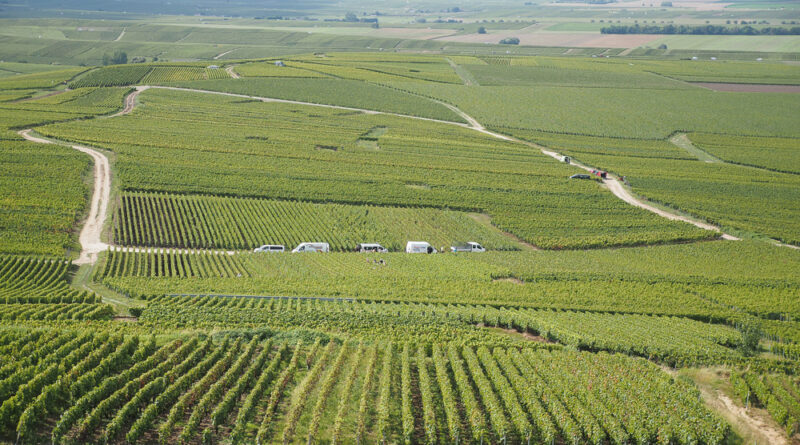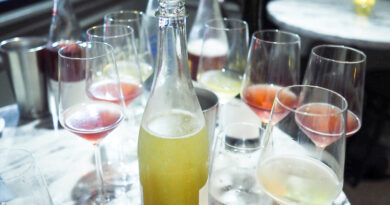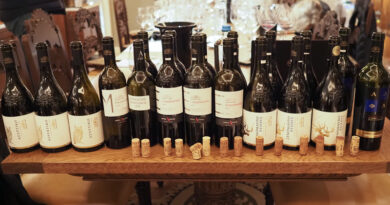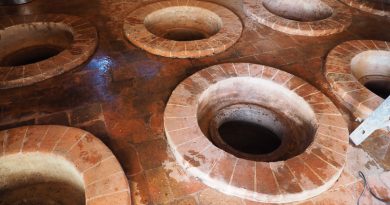Champagne: an introduction
Champagne makes the world’s most famous sparkling wines. Here’s a brief introduction to the region and its wines.
Where is it? In the northeast of France, at a latitude of 49 degrees north, which is close to the limits of where grapes will ripen. It has a climate with two influences: oceanic (or maritime, which moderates temperatures) and continental (with extremes: cold winters and hot summers), and the interplay between the two is important and imparts vintage variation. Generally speaking, though, this is a cool climate region, ideally suited to growing grapes that develop flavour at relatively low potential alcohol levels and with good acidity. These are important attributes for making tasty fizz.

Why the bubbles? Champagne is almost unique in the world of wine in that it’s a sizeable region almost completely dedicated to sparkling wines. In the past, before the advent of bottles cheap and strong enough to allow a second fermentation to produce bubbles, this would have been a region making still wines, which would largely have been pale red in colour. So from its inception, sometime around the fifth century CE, until well into the 18th century, Champagne became a celebrated wine region for wines quite different to those it is known for today.
Then the fizz came. These wines, usually a blend of red and white grapes, were hugely successful, but when tastes began to change in favour of deeper, darker red wines, it was time for the region to reinvent itself. These rather tart still wines turned out to be absolutely perfect as the starting material for making fizz.
Who invented it? You may have heard of Dom Pérignon, the monk from Hautvillers who is widely attributed with inventing Champagne back in the 17th century. While he was an important figure in the region, his attributed role turns out to be a bit of a myth. Champagne as we know it now owes a lot to the English, because it was Dr Christopher Merret who first described the process of using sugar to start a second fermentation in the bottle to create bubbles in wine, a process he described to the Royal Society in London in 1662. It isn’t clear whether Merrey invented it or just described it. The English also had the advantage of the technology for making strong lightweight bottles, needed to counter the pressure created by a second fermentation. The French gained this bottle technology at the beginning of the 18th century and soon after the first deliberately sparkling bottled Champagnes were made. The first Champagne house, Ruinart, was founded in 1729.

How do the wines become fizzy? Still wines, known as base wines, are made from freshly harvested grapes, both red and white. Then, after a few months ageing, they are blended together, sometimes with an older wine or two known as reserve wines, and bottled. But some sugar and yeast is added at this stage, and a second fermentation takes place in the bottle. This creates the bubbles, which at this stage aren’t bubbles because they are carbon dioxide dissolved in the wine. On opening and pouring, the dissolved gas is released as bubbles form in the wine.
How big is the region? The borders of the official Champagne appellation were set in law in 1936, and includes 320 villages in five départments. It’s only certain parts of this larger area that are allowed to be planted with vines, and this depends on the quality of the soils. Since Champagne was demarcated by law, the region’s production has grown. In 1950 around 30 million bottles were made. This has increased tenfold to the current level of around 330 million bottles, which come from 34 300 hectares of vines.




It’s all about the soils. And these are mainly chalk, and the ones that aren’t chalk are a different sort of limestone. The chalk soils are the result of a huge sea that covered the region some 70 million years ago during the Cretaceous era. They are what are known as sedimentary rocks, which have formed by deposition over a long period, and the chalk comes from fossils of limestone-shelled marine creatures. In some places the chalk is very thick indeed: as much as 300 metres. It’s known as the Paris Basin limestone layer and it crosses the channel to the south of England, some parts of which have soils that look very similar to those of Champagne. But a quarter of the region has older limestone soils that are quite different. The Côte des Bar in the southeast of the region has soils from the Jurassic, with Kimmeridgian limestone and marl, as well as calcareous clay. There is variation across the region, with differences in the exact type of limestone or chalk, the depth of the top soil, and the presence of clay or sand in the soils. How do these soils affect the flavour of the wines? We don’t know for sure, but limestone in general does seem to give a bright feel to the acidity of wines made from grapevines grown in it. It’s able to hold water and then release this slowly to the vine, and has a high pH (it’s more alkaline than acidic).
Look out for the two letter code. All Champagne bottles have a two letter code indicating the type of business who made the bottle, followed by their registration number:
NM Négociant manipulant – someone who buys grapes, must or base wines from others and makes wine. This is the category the famous Champagne houses fall into.
RM Récoltant manipulant – These are what are known as grower Champagnes, made by growers from their own grapes.
RC Récoltant-coopérateur – This is a grower who sells their grapes to a cooperative and then gets Champagnes back to sell under their own name.
CM Coopérative de manipulation – This is a cooperative, where growers bring their grapes to be made into Champagne. The cooperative will sell bottles, but can also sell the pressed juice or finished base wines to Champagne houses. Many of the famous houses buy must or base wines from cooperatives that they then use to make their wines, and sometimes these even find their way into prestige cuvées.
SR Société de Récoltants – This is a firm established two or more growers who share the same winery which they use to make wine to sell under their own label. It’s not the same as a cooperative, because the growers are also involved in making the wine.
MA Marque d’acheteur – This is a Champagne own-label or buyer’s own brand. Supermarket Champagne often falls into this category.
ND: Négociant distributeur – This is a wine merchant selling Champagnes under their own name.
Growers versus houses. Most of the famous names in Champagne are houses, and they sell 70% of the Champagne while owning just 10% of the land. This means that 90% of the Champagne vineyards are in the hands of growers, many of which sell to either Champagne houses directly, or to cooperatives, who might then sell their wines or who might sell the pressed juice or base wines to houses. But some growers make and bottle their own wine, from the vineyards they have farmed. There’s been a lot of attention on the growers, many of which have made some of the best Champagnes over recent decades. But growers aren’t all great, and it’s too simplistic to think that grower Champagne is the best and the stuff from the big houses is inferior. Besides, because of the cost of vineyards, many of the top growers have had to leave their grower status behind as they begin buying grapes in order to increase production – adding to their vineyard area is usually prohibitively expensive, with prices around €2.5 million a hectare.
Harvest. This usually takes place in September or October, but with climate chaos it has moved into August several times in recent years. The grapes are hand harvested into 50 kg bins which are then taken either to the wineries or to special press centres located in the vineyards themselves. The 50 kg bins are a compromise: for quality, slight smaller bins that one person can easily carry might be better, but these would make loading the press a more lengthy process and this could result in loss of quality.

The importance of pressing. Pressing is a vital stage in the production of Champagne, and here a lot of quality can be gained and lost. The standard press size in Champagne takes 4 tonnes (4000 kg) of grapes. The traditional press was a shallow circular basket press, but the latest style is the Cocquard PAI, which squeezes the mass of grapes between a tilted pair of plates, and is thought to yield higher quality juice. For a 4 tonne press load, the first 100 litres flows freely without any pressing, and is typically discarded or sold off as it often contains some dirt. Then the next press fraction is called the cuvée, and can be up to 2050 litres. This is the highest quality juice. The final 500 litres is the taille, and is kept separately. It might be used, or it might be sold off, depending on its quality. Typically the later press fractions contain more phenolics and have slightly lower acidity.
Champagne comes in different styles. The most commonly encountered Champagne is the NV (non-vintage) cuvée, which is made from base wines from different years blended together, and is composed of the three main Champagne grapes: Chardonnay, Pinot Noir and Pinot Meunier (which is often referred to simply as Meunier in the region). But there are five other grapes that may be used: Pinot Blanc, Arbanne, Pinot Gris, Petit Meslier and a new disease-resistant white grape called Voltis. Some Champagne houses have been naming their NV cuvée MV, for multi-vintage, and some are even numbering each release to create a greater sense of prestige for these wines. The second style is the NV Rosé, which is usually made by blending in red wine from the region at the base wine style. There might also be NV Blanc de Blancs (made from Chardonnay only) or NV Blanc de Noirs (made from Pinot Noir or Pinot Meunier or a blend of the two) in a producer’s range. Then there are vintage wines, from a single year, with the same style breakdown. Usually vintage wines come at a price premium. Finally, many houses have an icon or prestige cuvée, often made in limited quantities and always sold at a high price.

The other style difference concerns sugar levels. This is indicated on the label using some rather confusing terms. When Champagne is disgorged (the plug of dead yeast cells is expelled) the bottle is topped up using the liqueur d’expedition, which is based on wine (it can contain barrel-aged wine, or even brandy, for example) and which may have sugar added to it, called the dosage. Brut Nature or Zero Dosage means that no sugar has been added and the final wine contains less than 3g/l residual sugar. Then there’s Extra Brut, which can range from 0-6 g/l residual sugar, so there is some overlap here. Brut is 0-12 g/l sugar, and this is the most widely encountered category. The sweeter Champagnes are quite rare, but these categories are Extra Dry (17-32 g/l), Demi-Sec (32-50 g/l) and Doux (more than 50 g/l).
Ageing in the cellar. One of the benefits of being on top of a very thick layer of chalk is that it’s easy to dig cellars. And these cellars are needed for ageing the wines after they have been bottled for the second fermentation. It takes a while for the second fermentation to take place (which adds the bubbles) and then even longer for the dead yeast cells to begin to die and release flavour compounds into the wine – a process called autolysis. Legally, Champagne must stay on these yeast lees for 18 months before disgorgement, but many houses will age their wines for much longer. Three or five years on lees normal for some of the top wines, and some go even longer.
It’s not all about age. When I first learned about Champagnes I was told that base wines are mean, acidic and not nice, and that all the character for the wines comes from the secondary fermentation and ageing on lees. While long lees ageing is a great way to add character and personality to Champagne, it’s only part of the story, and there’s much more to fine Champagne than the toasty flavours of autolysis. Increasingly, top producers – and notably many of the leading growers – are creating flavour and complexity in base wines, and then only ageing a relatively short time on lees in the cellar. These wines are often the most compelling terroir-expressive Champagnes.




